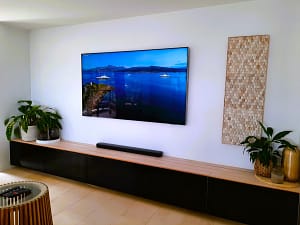
In today’s digital age, televisions have become a central elements of our homes, providing entertainment, information and connectivity. As TVs become larger and sleeker, many homeowners are choosing to wall-mount their television sets to save space and enhance the aesthetics of their living spaces. While this trend can create a modern and visually appealing look, it is crucial to consider the safety aspects of wall-mounting a TV to prevent potential accidents and ensure a secure installation.
In this article, we will explore the key safety considerations when wall-mounting a TV and provide tips to help you make the process not only aesthetically pleasing, but also safe for your family and your investment.
- Select the appropriate wall-mounting bracket
Choosing the right wall-mounting bracket is the foundation of a safe installation. Different types of brackets are available, including fixed, tilting and full-motion brackets. To ensure safety, you must consider the following:
- The size and weight of your TV: Brackets are designed to support specific size-and-weight ranges, so it’s essential to select one that matches your TV’s specifications.
- Wall compatibility: Make sure your wall can support the combined weight of your TV and bracket. If you have a plasterboard wall, you may need additional support, such as wall studs or a backboard.
- VESA compatibility: The bracket should align with the VESA (Video Electronics Standards Association) pattern on the back of your TV to ensure a secure fit.
- Wall Inspection
Before mounting your TV, you must thoroughly inspect the wall where you plan to install it. Ensure that the wall is structurally sound. If you’re uncertain about the wall’s stability, consult with a professional contractor or a handyman to assess the situation.
- Locate Wall Studs
Studs are vertical wooden or metal beams that provide the necessary support for your TV and wall mount. Use a stud finder to locate these studs, ensuring that your wall mount is anchored securely. Do not rely solely on wall anchors, as they are not as reliable as securing your TV to wall studs.
- Conceal Cables and Wires
Safety is not just about the mounting itself; it also involves minimizing tripping hazards and creating a neat and organized appearance. Use cable management systems to conceal wires, ensuring they don’t hang loose or pose a risk to your family.
- Install at the Right Height
The ideal TV height is eye level when seated, which minimizes neck strain and discomfort. Ensuring your TV is at the correct height contributes to both your viewing experience and overall safety.
- Regular Maintenance
Wall-mounted TVs require regular maintenance to ensure their continued safety. Inspect the bracket, screws and wall anchors periodically to ensure they remain secure. If you notice any signs of wear or loosening, take immediate action to address the issue.
- Childproofing
If you have children in the house, take additional steps to childproof your wall-mounted TV. Consider adding safety locks or guards to prevent accidents like the TV from being pulled off the wall.
Conclusion
Wall-mounting a TV can enhance the aesthetics of your living space and save floor space, but it’s imperative to prioritize safety during the installation process. By selecting the right bracket, inspecting your wall, locating wall studs, concealing cables, and maintaining your setup, you can ensure the safety of your family and protect your investment. With the right precaution and regular maintenance, your wall-mounted TV can offer both; style and peace of mind in your home.
